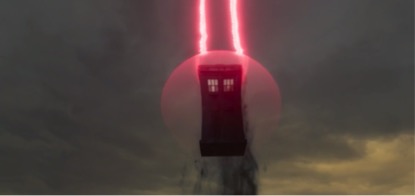Doctor Who: 10 Things You May Not Know About ‘Fugitive of the Judoon’
“Fugitive of the Judoon” is quite a simple story, but one with a very complex ending, rooted in both arcane Gallifreyan lore, and the lore of a timey-wimey TV show that has been around for nearly 60 years.
So, while some of the extra bits and bobs mentioned here might be relatively straightforward, some are as fiddly as plaiting sawdust. We make no apology for this. This is the kind of temporal complexity Doctor Who fans were reared on. It’s not all “EXTERMINATE” and sonic screwdrivers, y’know.
Anyway, here are a few things to keep an eye out for, the next time you watch:
1. The Judoon captain is named Pol-Kon-Don as a tribute from Chris Chibnall to his friend, the BBC Online producer and DW superfan Paul Condon. Paul died in 2019, prompting this tribute from Chibnall in Doctor Who Magazine: “He was a shining example of the best in Doctor Who fans: he loved the show with passion, kindness, empathy and celebratory humour. So I was floored to get a text telling me Paul had died suddenly, at 49. So many eulogies have sprung up in the wake of his unexpected death (often accompanied by him cosplaying the Thirteenth Doctor, which I hadn’t seen): nobody had a bad word to say about him… We should all Be More Paul.”
2. Ruth is seen to be celebrating her 44th birthday. In a possibly intentional twist of fate, 44 years (and two days) prior to the broadcast of this story, the BBC put out the final episode of the Fourth Doctor story “The Brain of Morbius”. This showed a battle of brains featuring other incarnations of our favorite Time Lord, that appear to pre-date the First Doctor.
3. Ruth is quite clear on her expert knowledge of Gloucester Cathedral, but what she does not mention is that parts of “The Next Doctor” were filmed there. Probably another iteration of the Blinovitch Limitation Effect in action.
4. Speaking of which, when Gat refers to two of the same Time Lord being present in the same moment as an “abomination,” that’s a harsh retelling of a central core of Doctor Who science. The Blinovitch Limitation Effect is a fictional principle of intertemporal travel invented during the Third Doctor’s era to explain why time travelers can’t have do-overs until they get what they want. This reference was then fleshed out, with “Ghosts of N-Space” showing Aaron Blinovitch (fictional) writing his physics masterpiece Temporal Mechanics (fictional) in the British Library (real).
5. References to Blinovitch pepper Doctor Who. As recently as “Kill the Moon” the Doctor predicts that Courtney Woods will meet him on the way to becoming President of the United States. And she was also in Peter Harness' original draft of “The Zygon Inversion,” becoming became a pro-Zygon freedom fighter under the name Blinovitch.
Curiously, the one character who seems to be mostly immune to the Blinovitch Limitation Effect (besides the Doctor) is Amy Pond, who has met herself several times with very few side effects.
6. The Judoon grab hold of the TARDIS with a tractor beam, which is a fairly commonly used term in science fiction, especially for something that doesn’t exist at present, beyond early successes at a microscopic level. The phrase came from E. E. Smith, who started using the term “attractor beam” in his 1931 novel Spacehounds of IPC, and contracted it from there. Which means it is not, as one might reasonably have assumed, a beam that does the work of a tractor.
7. The idea that Captain Jack Harkness is cheesy – as commonly agreed by Ryan, Yaz and Graham – is well established. Mickey Smith called him the same thing, even embellishing it to a full nickname: Captain Cheesecake.
8. And while Ruth has been keen to share the glories of Gloucester Cathedral to anyone who will listen, Doctor Who invaded another cathedral – Clifton Cathedral in Bristol – to dress up as the alien spaceship stolen by Captain Jack.
9. Two more deep dives to end on. The idea of a secret Gallifreyan military sect working on covert operations – and ultimately breaking the Time Lord rules about intervening in the affairs of other worlds – is an echo of a similar organization described in such short stories as “The Legacy of Gallifrey” from Doctor Who Magazine. The Celestial Intervention Agency (yes, the CIA), performed similar operations and was even led by the great Time Lord leader Rassilon.
10: There is also a fan theory, which became a source of alternative (and now official) new Doctor Who media, that the Second Doctor became an agent of Gallifrey in the temporal space between being captured by the Time Lords at the end of “The War Games” and actually becoming the Third Doctor in “Spearhead from Space”.
The “Season 6B” theory claims that he and his companions Jamie and Victoria were indeed exiled to Earth but worked for the CIA, going on missions which included his appearance alongside the Sixth Doctor in “The Two Doctors”.
It was immediately suggested after this episode was aired that Ruth might be an incarnation of the Doctor that appeared after the Second, but before the Third. Whew.
Do you have a favorite moment from “Fugitive of the Judoon”?
